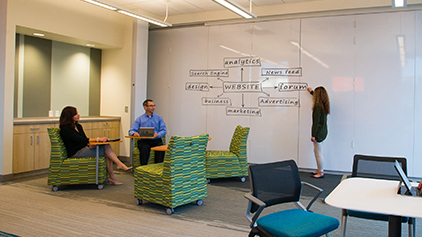When CBRE Group moved to a workplace designed around wellness, 93% of their employees said they wouldn’t go back to the old way of working!
Recently the workplace wellness conversation has begun to focus on how the physical working environment impacts wellness. Over a third of our waking hours are spent at work, so it should come as no surprise that data from recent research into offices, call centers, and even retail stores shows that the physical working environment has an enormous impact on employees’ overall health and wellbeing.
From the way buildings facilitate or obstruct the work we do to the way they stimulate our minds, the design of a workplace has a huge effect on our wellbeing. Purposefully designed workplaces can promote movement, reduce stress, and make it easier for us to do our work, while better heating and cooling and lighting systems can provide a healthier and more comfortable environment. Let’s take a look at a few ways that workplaces can support employee wellbeing.
A Focus on Movement
Which do you think is more dangerous for your health, skydiving every Saturday or sitting at your desk during the week? At one death per hundred thousand jumps, this extreme lifestyle of weekend skydiving would increase your chance of dying by about 28% over the average person’s 0.18% chance of dying for any given reason this year. But ten hours in a chair every day increases the probability of your death by 34%!
Movement focused workplaces are turning into wellness and productivity success stories, featuring design choices that facilitate easy collaboration and encourage more time be spent away from desks. Casual meeting spots offer a convenient alternative to inter-office email chains, and break rooms that have room to breathe provide conversations zones where employees feel comfortable drinking coffee and eating lunch away from their desk. Moving the printers from employees’ desks to a central area gives them another reason to get up and walk, and it also creates a collision area that inspires unplanned meetings and sharing ideas between employees who don’t usually work together.
A meta-analysis of over a decade’s worth of studies shows that cutting just an hour or two of daily sitting drastically cuts your risk of dying of any cause, a statistic that more than justifies the investment in a movement focused workplace.
A Variety of Workspaces
Sitting in the same place all day isn’t just bad for your body, it can be bad for your mind as well. Think about how you’ve felt working in different types of workspaces. Open offices are great for collaboration, but noise levels disrupt focused work. Cubicles remove some distraction, but many employees find them depressing. No one workspace can ideally support the variety of work that you do throughout the day, and this situation generates a significant amount of stress.
So if any given workspace isn’t ideal, why not have them all? This is the idea behind Activity Based Working. By designing a variety of workspaces around activities as opposed to designing uniform work stations for all employees, you free your team to choose the working environments that best support the different types of work they do throughout the day.
Stress exacerbates many health conditions, and most workers report feeling stressed at work. Providing a choice of workspaces and the ability to avoid stressors is an effective way to improve employees’ overall health.
Exposure to Natural Light
Remember being warned as a child that reading a book in the dark would damage your eyes? Well, that’s not quite true, but reading and working in poor lighting conditions does have an effect on your health. The lighting typically found in offices often causes eye strain and can lead to headaches and stress.
The solution, according to a study by a US Department of Energy research lab, is to provide workers with natural light or simulated natural light through full spectrum bulbs. The IWBI recommends that at least 55% of an office space receives sunlight no less than 50% of the day, which can be achieved through architectural designs that maximize the use of sunlight.
The wellness benefits of addressing lighting issues go beyond just removing eyestrain and headaches associated with poor lighting. Natural light during the workday also syncs employees’ circadian rhythms to the work day, improving their sleep, increasing their energy levels, and further reducing work related stress.
Join the Conversation
Your physical workplace is already having a significant effect on your employees’ wellness. Do you feel that it’s a positive asset to your wellness effort? We’d love to hear your thoughts on wellness in the workplace and start a conversation about how you can best support your team through an office designed to support employee wellbeing.

